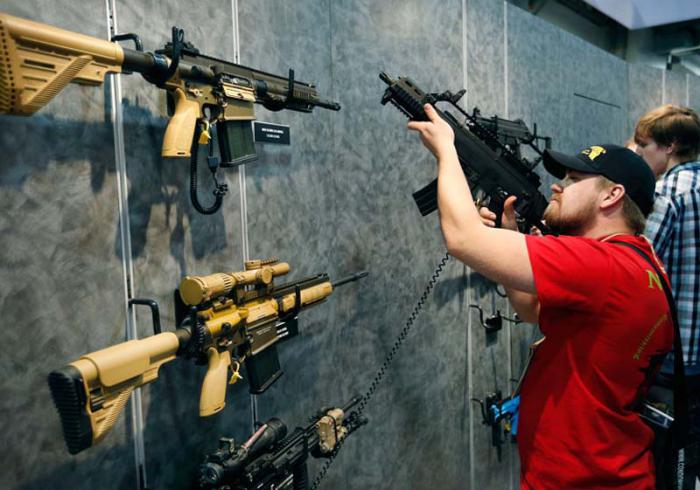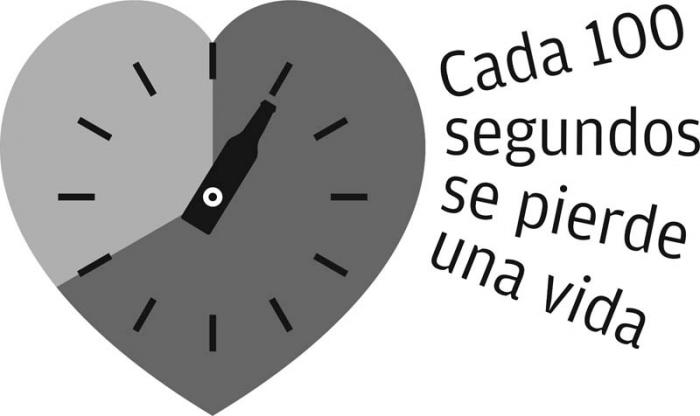Granma 299
Death Merchants

Death Merchants
The largest arms fair in the United States ended Friday near the site of the Las Vegas massacre, where 58 people died this past October 1.
By Alfonso Nacianceno internet@granma.cu
January 26, 2018 22:01:19
A CubaNews translation.
Edited by Walter Lippmann.

Gun industry tycoons say the American economy makes millions of dollars from arms sales.
Firearm sales skyrocket whenever a massacre, like the one caused by Stephen Paddock on October 1, 2017 in Las Vegas, takes place in the United States. It’s a sad truth that weighs heavily on its population.
The 58 deaths caused by this 64-year-old retired individual who fired into a crowd of more than 22,000 concertgoers at a country music festival gave rise to angry protests against firearms. However, the tycoons who showcase their novelties in any of the three arms fairs scheduled for 2018 in the U.S. consider theirs a serious line of business. It’s marked by deals worth millions and millions of dollars that benefit the U.S. economy and which, therefore, they are unwilling to abandon.
Never mind the feelings of those who are still mourning over the horrifying deaths of so many people. They only expected to have an enjoyable evening. The U.S. gun industry held its biggest annual fair for four days, just a few miles from the killing fields. Despite the general public’s astonishment and annoyance, Shot Show featured its products along 20 kilometers of aisles, adding to a history of more than 40 events, half of them held in Las Vegas, according to an AP report about the characteristics of this mega-event.
Over 1,700 exhibitors signed agreements and made deals worth millions, whereas the organizers tried to placate peoples’ logical concerns by assuring us that only gun manufacturers and dealers were allowed into the premises, the firing pins were removed from all guns on display, and there was no live ammunition.
Beyond any arguments behind the appeals for calm, absent from the show this time was the company Slide Fire, the leading manufacturer of bump stocks —attachments that enable rifles to fire faster— an invention used by Paddock in the deadliest mass shooting by a lone gunman in U.S. history. The Texas-based company has not said why it was not among the exhibitors, nor has it confirmed its presence at the National Rifle Association (NRA) meeting.
Even if Slide Fire’s bump stocks were not on display, the show presented other accessories made to enable gun users to mimic fully automatic fire and reduce noise.
In the wake of the massacre in Las Vegas, and as discussions about gun control continue, Pennsylvania hosted the Guntoberfest gun show, another huge shop window with similar interests as those of Shot Show’s. In addition to this recent exhibition, they have already planned for another two meetings of rednecks, as gun industry leaders are usually nicknamed.
Marine West, devoted to displaying the state of the art in heavy military equipment, will have a venue in Anaheim on February 7 and 8. And April 9 to 11 will see the third of these conventions at Camp Pendleton, the major West Coast base of the United States Marine Corps.
Figures provided by the Centers for Disease Control of that country—also in charge of recording the number of deaths by firearms—reveal that 33,000 die of gunshots every year; two thirds of the annual 12,000 homicide victims are African-Americans; and people between the ages of 15 to 64 are more prone to suffer fatal accidents.
The American citizens themselves have coined two lapidary sentences to describe the situation of helplessness that they are exposed to every single day:
“There are more guns than people in the United States… Carrying a gun is as common as having a flowerpot at home”.
Gender Violence…Does does it have to do with me?

Gender Violence…Does it have to do with me?
 Author: Msc. Mareelen Díaz Tenorio* | internet@granma.cu
Author: Msc. Mareelen Díaz Tenorio* | internet@granma.cu
A CubaNews translation.
Edited by Walter Lippmann.
It has to do with all people, human groups and institutions that share their existence in concrete socio-historical and cultural spaces. It could be thought that it is a question of women, or rather of “some women”. Some people believe that it is not a problem in Cuba, it is not so serious, or it is simply a fad that seeks to change our language by forcing people to talk about “the” and “the”. by using inclusive words such as “it” instead of using “he” when referring to both men and women.
THE ORIGINS
Let’s go in parts and start with its origins. Before having sons and daughters, people usually make up images about what the process would be like. Even if you do not think carefully or plan, in our heads, ideas and sensations are activated about what the child will be like, what name it will be given, how it will be dressed, what qualities it will have, what its occupation will be, what its relationship as a couple will be like and even the children it will have in turn.
A human being is built over the years. It’s a process in which not only the mother and father participate, but the rest of the family members with their diverse beliefs. In addition, the neighborhood, the school, friends, the religious group, workspaces, membership organizations, social media and many others play a role. In all that framework, the teachings and learnings, as a tendency, are marked by differences depending on whether the newly arrived child is considered a man or a woman
It is common to frame education or socialization according to pre-conceived beliefs that we transmit from generation to generation. The process starts at an early age and is reinforced throughout life. At pre-school age we teach children’s songs that forbid a girl to play because she has to do the laundry or iron the clothes on different days of the week «Monday before lunch, a girl wanted to play, but she could not play because she had to do the laundry…».
Likewise, in the song about the playful she-ant: “… she did nothing but play and her mom told her to come and help her clean …”. She is given the care of her sick mother, who only stops doing domestic work when she has to stay in bed due to incurable health problems. Girls are often given brooms and mops, cooking toys, ironing boards, princess dresses and make-up sets. Boys are given trucks, machines, pistols, baseball bats, swords, etc. As they grow up, each learns skills, trades and different professions for male and female, as well as ways of thinking, feeling and behaving.
FROM DIFFERENCES TO VIOLENCE
Society as a whole is transmitting these beliefs and stimulating a prevailing single acceptable way of being a man or woman. Women are supposed to be beautiful, delicate, obedient, passive, conciliatory, docile, weak, sacrificed, motherly, dedicated to domestic work and the care of sick and elderly people, given more to the private world of the family. Men are supposed to be strong, independent, competitive, virile, active, dominant, powerful, providers of family income, intrepid and daring, given more to the public. This pattern includes heterosexuality for both. As people move away from these sexist patterns, they are more likely to be rejected, discriminated against and violated. The type of society in which the dominance of the masculine and the subordination of the feminine is promoted is called patriarchy.
If these were just differences, it would not be so impressive. The issue becomes more complex when a deeper analysis leads us to understand that these differences become inequalities with negative effects for both. They become straitjackets that imprison the liberties and rights of people, based on false gender beliefs, on asymmetries of power between the feminine and the masculine that determine everyday life.
So-called gender violence lies in acting (or not acting), deliberately, based on inequalities and asymmetries of power. These are anchored in what is considered valid for the feminine and masculine from a patriarchal perspective and which causes physical, psychological, sexual, and economic damage.
Victims of gender violence can be found among people of any age, school level, social class, territory, income level or skin color. None of these variables excludes people from being victims or perpetrators of violence. Of course, when there are unfavorable living conditions, situations of violence and their solutions become more complex.
It is important to say that violence intersects. A person can be violated on the basis of gender and at the same time because someone is black, follows a certain religion, has a disability, poor [material] resources and/or lives in a specific region. The possible combinations demand the attention of each dimension.
CONSEQUENCES
Some of the costs of assuming the prevalent or hegemonic sexist masculinity include: difficulties in expressing painful emotions and feelings; pressure to maintain control over the partner, and violent handling of conflicts; non-responsible paternity and deprivation of the enjoyment of this role; problems with self-care such as resistance to exams for prostate cancer screening, or silencing health issues such as sexual dysfunctions; having simultaneous partners, promiscuity, risky sexual practices and permanent seduction; suicide and alcoholism when the role of provider cannot be fulfilled; obligation to have children; restraint of sexual orientation and gender identity; accidents.
While there are negative costs of the male pattern for men in patriarchy, the punishment for women who deviate from the norm established by this system has been widespread in the history of humanity and still is today. Gender violence against women is the most extensive and serious of gender inequalities. Among the consequences of this form of violence for women we can mention: personality problems such as insecurity, low self-esteem, little perspective for the future; depression, anguish, fear, sleeping and eating disorders; physical and psychological injuries; effects on health due to continued domestic overload throughout life; isolation from social spaces (family, school, friendships); limitations on autonomy due to prohibitions on their insertion and promotion in working life; sexually transmitted diseases and unwanted pregnancies; sequels of sexual violations; suicide and death.
The balance of damages transcends personal stories. The implications reach a high economic cost for people and for a country that needs to optimize resources to ensure sustainable development. The other side of the effects is social. As long as gender violence exists, it constitutes in itself a benchmark for the education of all generations. This means that if attention is not paid, if this is not taken care of, if this is not stopped, sexist patterns will continue being reproduced with social behaviors and fantasies that “justify” this type of violence against women as something “normal” that has always existed.
CUBAN CONTEXT AND THE COMPASS IN THE WALK
Thanks to social policies implemented decades ago, Cuba has very favorable indicators in gender equality. There are no identified forms of violence in the country that still exist in other regions of the planet. For example, ablation (amputation) of the clitoris [aka genital mutilation], sexual enslavement and torture of women as spoils of war in armed conflicts, or mass killings of women with impunity. However, there are forms of violence against women in our context, as shown by social research, health institutions, instances of the Cuban judicial system and the Houses of Counseling for Women and the Family (COMF) of the Federation of Cuban Women among others.
There is sexual, physical, economic and psychological violence. The latter, is always the most frequent because it is linked to the previous ones and can appear alone, is invisible or neglected. Some believe it does not leave traces when, in reality, it is necessary to “train” the eyes to identify it with its consequences. Some of its forms are shouting, silence as punishment and condemnation, prohibitions, impositions, disqualifications, threats, emotional blackmail, etc. Gender violence and especially that perpetrated against women constitutes a social, health and rights issue.
If situations of violence are experienced, the first recommendation is to ask for help. The problem is not private even if it occurs in the family or another social space. People can contact the COMFs that exist in each municipality, the doctor’s offices and polyclinics, Mental Health Community Centers, the National Revolutionary Police stations and the Attention Offices of the Attorney General’s Office.
Gender violence requires attention and prevention. The solutions need a look at the system, the analysis of its causes and the participation not only of different professionals, sectors and institutions, but also of state coordination and monitoring. This system is under construction so that it can yield real and sustainable results. It is essential that the whole society be involved. No one is left out. And yes, it has to do with me and with you, with men and women who want a just society without victims of gender violence.
* Psychologist at the Oscar Arnulfo Center
Buffalo Bill and the NRA

 Buffalo Bill and the Other’s Revolver
Buffalo Bill and the Other’s Revolver
Author: Rolando Pérez Betancourt | internet@granma.cuNovember 16, 2017
Translated and edited by Walter Lippmann for CubaNews.

On the 100th anniversary of his death, it has to be agreed that it was the spectacle, “show business”, that turned Buffalo Bill (1846-1917) into a legendary being and, at the same time, one of the par excellence promoters of firearms in the United States.
Buffalo, which was actually called William Frederick Cody, served as an army scout in the conquest of the West and also as a bison hunter to supply meat to the workers of a railway company. Having participated in the 1876 Sioux War allowed him to wear showman’s clothing for 20 years in a show that toured his country and Europe.
The two decades during which “Buffalo Bill conquered the West” came be the number one of the international shows that triumphed at the time, including Ringling [Brothers] Circus. It could be seen there, always in an excellent version in heroics, the old explorer fighting the Indians, among whom was Chief Toro himself seated, converted, or reduced by then, to one of the attractions of the troupe.
Numbers of cowboys, persecutions, beautiful galloping horses, all inspired by the border law, established thanks to a policy of territorial expansion carried out with the support of modern weapons. Standing in the center of his circus, holding a rifle, Buffalo Bill made an apology presenting them as heroes in the conquest of the West.
“Only one weapon in the hand will stop the other,” he used to condemn as a forerunner of an ideology of violence that would later become a cultural reasoning enthroned in much of American society. A firearm is a right and a protection “has been tried to make citizens believe, along with the support of an entertainment industry that extols each other’s death for the sake of life. This, unfortunately, translates into a staggering figure: 117,000 people are shot in the United States each year, statistics that involve both aggressors and defenders.
Buffalo Bill’s time coincided with the creation of the National Rifle Association (1871) that had in the showman one of its champions. It is an entity that, to this day, and from its economic power, has not ceased to foster close relations with American political power.
Now, on the 100th anniversary of the death of showman Buffalo Bill, another showman, President Trump, defending “bang-bang” culture”, makes us remember the extinct persecutor of Indians. He declares, to the bewilderment half the world -and referring to the shooting in Texas, in which a young white man killed 26 people in a church and wounded 20- “fortunately, someone else had a gun and fired in the opposite direction”.
Samsung’s smart TVs spy on their customers

As in the novel ‘1984’:
Samsung’s smart TVs spy on their customers
Owners of the Samsung ‘Smart TV’ should watch their words in their own home if they do not want to disclose personal information.
Author: Redacción Digital | internet@granma.cu
Translated and edited by Walter Lippmann.

Samsung Smart TV. Photo: RECOMBU.com
Samsung’s privacy policy regarding Smart TV technology warns that its television sets ‘listen’ to every word of the customer and advises users not to talk about personal or confidential information near their television sets.
Please note that if your words include personal or confidential information, that information will be among the captured data and will be transmitted to a third party through the Voice Recognition function “, says the privacy policy of the company on their smart TVs.
“Although Samsung does not record its pronounced words, it can collect associated texts and other data,” explains the company, which clarifies that it will use it “to be able to evaluate the performance of the function and improve it.”
In short, owners of Samsung’s ‘Smart TV’ watch what they say in their own homes.(Taken from RT)
Let’s talk about alcohol

Let’s Talk About Alcohol
Alcoholism is a growing challenge for the countries of the area, which on average consumes more than in the rest of the world.
Author: Lisandra Fariñas Acosta | lisandra@granma.cu
17 January 2016 21:01:31
A CubaNews translation. Edited by Walter Lippmann.

Every 100 seconds, one life is lost.
It is scientifically proven that, as a result of its excessive consumption, alcohol diminishes the average lifespan of the population by more than ten years. This should be sufficient to maintain the commitment to combat this drug, which is legal but constitutes a health problem in Cuba.
Alcoholism, according to the report on the Regional Situation of Alcohol Consumption and Health in the Americas, issued by the Pan American and World Health Organizations, constitute a growing challenge for the countries of the area. Keep in mind that in the Americas region, alcohol consumption is, on average, higher than in the rest of the world.
According to the text, the burden of morbidity (diseases and trauma) is significant, as alcohol consumption contributes to the development of 200 diseases and damages/injuries, including neoplasms, HIV/AIDS infection and various mental disorders.
Cuba is no stranger to this health problem and the statistics do not lie. More than 45% of the population over 15 years old consumes alcoholic beverages, mainly in the age range of 15-44 years old. Meanwhile, the majority of alcohol-dependent people are between 25 and 42 years old, according to research by the National Unit for Health Promotion and Disease Prevention.
It is clear that the tendency towards having the first drink is becoming earlier and earlier in life, without establishing differences by sex. Recent studies suggest that women drink today at the same level as their male counterparts, a trend that complicates this scenario, if we take into account that females, biologically and psychologically, are more vulnerable.
Experts warn that once women are introduced into the field of consumption, they are much more discriminated against and censured. They drink faster and take longer to seek help because of the stigmata with which they carry this scourge, in the midst of an eminently macho society, which delays treatment and hinders rehabilitation.
However, the results of the latest Multiple Indicator Cluster Survey (2014) showed that the proportion of men who drink alcohol is higher than the proportion of women. Alcohol consumption before the age of 15 is more common in men than in women (11% versus 3% respectively).
On the other hand, alcohol consumption is more common in urban areas, equally for both sexes, while in women alcohol consumption is more common in the capital. The highest percentage of alcoholic beverage intake is identified in the center of the country with 53%. Women in higher education consume more alcohol (24%) than those in lower education. In men, the highest percentage of consumers is among those who have not studied or who have only reached the primary level, according to the survey.
It is imperative for Cuban society to know where the gaps that condition this situation are, as well as the cultural and imitative patterns that are repeated within households. There are many places today that encourage irresponsible consumption of alcohol and it is not difficult to access drinks, although the law prohibits the sale of these products, in addition to tobacco, to minors under the age of 18.
“The bottle” often ends up in the hands of the teenager, in flagrant violation of his right to preserve his health. In addition, paradoxically and contrary to what is legally stipulated in almost all countries, in our environment it is frequent to travel through public spaces bottle in hand, and nobody talks about having a Dry Law, but about responsible consumption that allows avoiding risky behavior.
Professor Ricardo González Menéndez, a renowned expert on addictions, warns us well in his article La atención integral al alcoholismo: experiencia cubana [Comprehensive Attention to Alcoholism: Cuban Experience]. He reflects on how “although alcohol and alcoholism are currently considered as the drug and drug addiction of greatest socioeconomic and human significance, little progress has been made with regard to the classic global social attitude of underestimating it as a health problem when compared to other drug addictions”.
However, the negative impact it has on all areas of the life of the individual and those around him or her, as well as its gateway drug status, make alcoholism not only a health but also a social problem.
Around 75% of the world’s drug addicts do not receive professional help. However, Cuba’s health system has, on the other hand, provided ways to confront this problem at all levels of healthcare.
We start from an integrated network of services and various forms of care for the alcoholic patient, ranging from primary care in the community to hospital services specializing in addictions. Community Mental Health Centers or polyclinic teams are essential links in the rehabilitation of patients suffering from this and other addictions.
Lack of labor discipline, a problem that needs solving

Lack of labor discipline, a problem that needs solving
Author: Lourdes Perez Navarro
January 10, 2009 0:40:08 CDT
A CubaNews translation.
Edited by Walter Lippmann.
A little over two years ago, the Resolution 188 of 2006, issued by the Minister of Labor and Social Security, came into effect. Consequently, institutions created or updated their internal disciplinary regulations. The aim was to strengthen labor discipline, educate the workers and deal with the lack of discipline and illegalities present in work places.
The draft [of this Resolution] was discussed and analyzed in meetings with workers before its approval, because it establishes rules and obligations at the workplace. Obligations include punctuality, meeting schedules, not leaving the workplace during working hours without permission of the supervisor, etc. It also states prohibitions like, not punching the card or signing the attendance record of another employee, and serious offenses, such as repeated absences, unjustified unpunctuality, and disregarding warnings and remonstrances.
According to Resolution 188, administrations are obliged to disclose and permanently explain to the workers the internal disciplinary regulations. Workers must obey regulations, or be subject to different disciplinary sanctions, depending on the gravity of the infraction.
It is known that lack of labor discipline slows production rates, erodes service quality and efficiency, and damages the country’s economy. It also dissatisfies the population. For example, if a machine operator doesn’t arrive on time, he interrupts or reduces that day’s production. If a lab technician is absent from work, a number of clinical trials can no longer be made.
These things are happening now. Specialists of the Ministry of Labor and Social Security monitored 2 042 companies and budgeted units during May-June 2008. The study showed that 60% of the workers did not comply with their working day.
They recorded 26 622 violations of labor discipline. Some of them were: late arrivals (46%), taking more than the allotted time for recess and eating (19%), working less than the stipulated working hours(13%), leaving before closing time(10% ) performing other unauthorized activities (5%), and leaving the workplace without proper authorization (4%).
Are a lot of financial and material resources needed to control and enforce discipline and efficient performance during the working day in each workplace? Or do we need more control, supervision and organization at the workplace?
Local administrations and directors are responsible for ongoing observation and control of how their workers comply with their obligations and abide by the rules established. Higher instances must be more demanding.
Why are internal disciplinary regulations put away in a drawer? On the contrary, they should be displayed on the workplace bulletin board, so all workers can see them. The Boards of Directors should periodically discuss the results of internal control checks.
Lack of labor discipline is not only personal. Certainly, those who violate discipline have names, and are liable to disciplinary actions that affect their pocket, their prestige or, in more serious cases, cost them their jobs.
But, this is not the only consequence. It damages the workers collective image, hinders completing economic plans, and affects the quality and efficiency of service. That is why labor discipline should be discussed in workers assemblies, at least once each quarter. This can not continue to be a problem.
Cabalgando con Fidel – English lyrics

Cabalgando con Fidel
[Riding with Fidel] by Raúl Torres
Song composed by Raúl Torres
Author: Raúl Torres | Internet@granma.cu
December 1, 2016 02:12:10
A CubaNews translation. Edited by Walter Lippmann.
They say these days
Camilo and Marti have been seen
Riding along on Revolution Square.
And that leading the caravan
Slowly trots a riderless horse
For you.
Open are the wounds that never heal
Of the men and women
who will never let you go.
Today our hearts beat in that square
It hurts so, but your people
do not want to see you go.
Man: the grateful ones are with you.
We shall all miss your great deeds.
Even Death cannot believe it took you.
Man: we learned to know you’d be eternal.
Just as Olofi and Jesus Christ,
There is not a single altar without a light for you.
Today I don’t want to call you, Comandante;
nor ‘barbudo’ nor ‘gigante’.
Or everything I know of you.
Today I want to shout “father of mine”
Do not let go of my hand
I still cannot walk without you.
Man: the grateful ones are with you.
We shall all miss your great deeds.
Even Death cannot believe it took you.
Man: we learned to know you’d be eternal.
Just as Olofi and Jesus Christ,
There is not a single altar without a light for you.
Man: the grateful ones are with you.
We shall all miss your great deeds.
Even Death cannot believe it took you.
Man: we learned to know you’d be eternal.
Just as Olofi and Jesus Christ,
There is not a single altar without a light for you.
They say that the square this morning,
Is completely full of horses,
Coming from far beyond.
A desperate crowd
of heroes with wings on their backs
Who have gathered there.
And leading the caravan
Slowly trots a riderless horse
For you.
Raúl Torres
———————————————————–
Cabalgando con Fidel (+Video)
Canción compuesta por Raúl Torres
Autor: Raúl Torres | internet@granma.cu
1 de diciembre de 2016 02:12:10
Dicen que en la plaza en estos días
se le ha visto cabalgar
a Camilo y a Martí.
Y delante de la caravana
lentamente sin jinete,
un caballo para ti.
Vuelven las heridas que no sanan
de los hombres y mujeres
que no te dejaremos ir.
Hoy el corazón nos late afuera
y tu pueblo aunque le duela
no te quiere despedir.
Hombre, los agradecidos te acompañan
Cómo anhelaremos tus hazañas.
Ni la muerte cree que se apoderó de ti.
Hombre, aprendimos a saberte eterno.
Así como Olofi y Jesucristo,
no hay un solo altar sin una luz por ti.
Hoy no quiero decirte, Comandante,
ni barbudo, ni gigante
todo lo que sé de ti.
Hoy quiero gritarte «padre mío»,
no te sueltes de mi mano,
aún no sé andar bien sin ti.
Hombre, los agradecidos te acompañan.
Cómo anhelaremos tus hazañas.
Ni la muerte cree que se apoderó de ti.
Hombre, aprendimos a saberte eterno.
Así como Olofi y Jesucristo,
no hay un solo altar sin una luz por ti.
Hombre, los agradecidos te acompañan.
Cómo anhelaremos tus hazañas.
Ni la muerte cree que se apoderó de ti.
Hombre, aprendimos a saberte eterno.
Así como Olofi y Jesucristo.
No hay un solo altar sin una luz por ti.
Dicen que en la plaza esta mañana,
ya no caben más corceles
llegando de otro confín.
Una multitud desesperada
de héroes de espaldas aladas
que se han dado cita aquí.
Y delante de la caravana
lentamente sin jinete,
un caballo para ti.
Today’s youth… lost?

Today’s youth… lost?
Author: Leticia Martínez Hernández
May 22, 2009
A CubaNews translation.
Edited by Walter Lippmann.
 I admit it: it bothers me when my generation is called into question, not taken seriously and, worse yet, branded a lost cause, a very good reason to annoy the most even-tempered of souls, of which I am one. Is the word ‘lost’ by any chance synonymous with irreverent, revolutionary, nonconformist, impetuous, determined…? I don’t think so.
I admit it: it bothers me when my generation is called into question, not taken seriously and, worse yet, branded a lost cause, a very good reason to annoy the most even-tempered of souls, of which I am one. Is the word ‘lost’ by any chance synonymous with irreverent, revolutionary, nonconformist, impetuous, determined…? I don’t think so.
A few days ago I took a bus, a bag hanging on my shoulder. Just by chance I found an empty seat beside a boy wearing the latest styles, tattoos and earphones included, who was also carrying something.
As chance would have it, we got off at the same stop, and I felt a great sense of relief when he insisted on helping me down the steps of the rear door with my load, his own notwithstanding. Like a harbinger of doom, the gloomy phrase suddenly came to me, as did memories of so many other boys and girls in their twenties who would leave more than one skeptic at a loss for words, and some who do give their nitpickers cause to complain.
Should we call lost those youths who stormed into the Isle of Youth, Pinar del Río, Holguín, Las Tunas and other Cuban provinces to share the pain of –and ease the burden on– the victims when the heavy rains and strong winds laid into Cuba last September? Or those who for the first time got their hands dirty trying one way or another to reap some benefit from the wounded land? I remember some of tem doing their best to make sad children laugh while their own family had no roof over their heads.
And the thousands of young Cubans who keep our education system going today, are they also the target of those fire-and-brimstone statements? Do the skeptic know anything about the nights those youths spend preparing their lessons while others their age are having great fun at a party; about how nervous they are on their first day in front of a class; about how they puff up with pride to be teachers even before their twentieth birthday; about the overwhelming burden that mistrust places on their shoulders?
Would the word ‘lost’ apply to those boys and girls who ache for their faraway loves as they stand day and night on our coastal reef to watch over every stretch of this country? If they only knew about Lester and his stubborn patrolling along some far-flung beach of Guantánamo province, or about Javier’s great responsibility for a radar who does nothing but sweep the sea surface!
A colleague heard of the paper I work for and asked my age right away: “And at 25 you’re already writing for Granma?” I had to summon up my patience for a long while –someone else said once that we were being ripened with carbide– before I told him of so many others like me he could find walking the halls of the official organ of the Communist Party of Cuba, where they spend countless hours waiting for closing time or hunting for the best thesis to finish a report while listening to [Cuban folk singer] Silvio, taking a few dance steps or exchanging jokes.
Have the doubters forgotten the exploits of those beard-wearing boys who cut their way through the bush in the Sierra Maestra Mountains and then raided our cities to disrupt the existing order inside Cuba and out? If a brilliant man like Fidel has always trusted in our youth’s creative strength, why are there others who allow themselves the luxury of casting a shadow over them? We could fill endless pages with stories of young people who are underestimated on arguments as flimsy as their lack of experience. How different everything would be had the pioneers of this Revolution waited for the lazy, slippery experience…!
It’s true that things are different now and it’s no longer our role to be heroes in the crossfire, but the bullets now aimed at our heads are far more dangerous. Today’s average youth must place limits on their aspirations, chances of personal fulfillment and even opportunities to have fun at the same time as they are showered with deceitful canons designed to convince them there’s a better way of life outside our country. And despite the few who may fall for the swan song and others who allow despondency to get the better of them, millions remain who refuse to give in and still fight for their homeland’s future.
What do they mean then by saying that youth, my youth, is hopeless? That we wear provocative and stylish clothes, live noisily, say what we think without a second thought, dream of possible and impossible things, dare to take on responsibilities we have no idea we can ever fulfill, never wait until tomorrow to pledge our commitment to the future… ? If these are the answers, then not only are we lost, we don’t want to be found.
Women’s Counseling Homes: an Indispensable Service

Women’s Counseling Homes: an indispensable service
Author: LUZ MARÍA MARTÍNEZ ZELADA
La Habana, jueves 20 de agosto de 2009. Año 13 / Número 233
A CubaNews translation.
Edited by Walter Lippmann.
 In the last 19 years, around three million people have been received in Woman and Family Counseling Homes in Villa Clara province, a sign of the social impact these services have on the community.
In the last 19 years, around three million people have been received in Woman and Family Counseling Homes in Villa Clara province, a sign of the social impact these services have on the community.
The first of these facilities was opened in the capital city Santa Clara on September 8, 1990 as a prime objective of the work undertaken by the Federation of Cuban Women (FMC), in charge of a 170-strong network of these centers nationwide.
Their main purpose is to deal with concerns related to real gender equality, child upbringing, legal guidance and the provision of training in several skills of citizens who don’t work or go to school.
Provincial FMC board member Mayelín Díaz told AIN the organization will celebrate its 49th anniversary on the 23rd with outstanding results in this sphere.
New projects like the Family Courts –consultancy on legal topics regarding couples and childcare– come on top of this effort, she added, which our centers provide in the form of interpersonal communication skills and measures to prevent family violence, alcoholism, AIDS and drug use.
Idalmis Pedroso, a beautician who has given hairdressing and cosmetology courses in one of these local institutions for 18 years, talked about the importance of these programs to help men and women who neither work nor study to learn a a trade and better reinsert themselves into society.
All the 17 Counseling Homes in this central province are staffed by half a thousand volunteer professionals, including psychologists, teachers, attorneys, doctors and speech therapists.
We need to save. But, …how?

We need to save. But, …how?
Author: Leticia Martinez
August 8, 2009
A CubaNews translation.
Edited by Walter Lippmann.

I confess I don’t know much about electricity. Both my parents are Automatic Control Engineers and still, I was not the least bit interested in the subject. Besides realizing electricity is needed to move the world, I was never curious as to how they generate it or how much does it cost. Lately, everyday we hear about the need to save it and announcements have brought the subject to the fore.
Dozens of articles on saving or wasting kilowatts, on measures to complete energy plans, on stealing electricity, and on the work of inspectors reach my hands. But, day-to-day reality is more complex. To tighten the belt of saving up to the point of asphyxia has motivated me to write some lines. First I must declare I lift a banner of rationality. I am for saving with intelligence and after proper studies.
As one who is ready to part with something very valuable, I went to the pizza place located on one side of the Trianon Theater. I was celebrating an important date and money was not the most important issue that day, or worrying about what I would do at the end of the month. If what happened to me hadn’t been so absurd, it could move people to laughter. When I ordered two pizzas the waitress answered: “From 6 in the afternoon to 10 in the evening we don’t make pizzas because we are not allowed to turn on the oven”. My mouth fell open, not because I was ready to fill it with the desired pizza, but because behind me other customers were asking for the same thing and leaving absolutely astonished.
I remember it was a Saturday and lots of people were leaving nearby theaters. Others were beginning to enjoy the night and Linea [one of the main streets in Vedado] was full of people. In the meantime, the pizza place waitresses looked very bored leaning against the counter. They were lamenting not being able to sell pizzas. This is the time when most people come by. But, we cannot sell because now the priority is saving, one of them said with the tone of one who doesn’t believe in what she is saying.
And, if this were the only instance there would be nothing to worry about. But, one of my colleagues told me the same thing happened the other night close to the Monaco Theatre, where more than three cafeterias were closed for the same reason. It seems absurd that services are not offered because of some saving plan.
Something similar happens in convenience stores, where these days the only thing we find is an unbearable heat and the dull and sweaty faces of clerks, who are more intent on feeling cooler than on selling. How many clients simply decided no to buy anything rather than withstand such torture, and how many more bought only the most needed things to end it quickly. The pleasure of entering a store and calmly looking for whatever one wanted, or maybe even something extra, has vanished.
We might add to our prior arguments that there is also the possibility some food products might deteriorate, and that it is not very healthy to remain in closed spaces full of clients. Furthermore, if under ideal conditions sometimes clerks do not treat clients well, now it is commonplace.
Focus has been placed on the use of air conditioners, and we can understand why. But, has anyone considered that it can be very harmful to turn them off in certain places? Is it logical to turn them off in places with no windows and full of personnel and computers? Has anyone calculated how many computers could break down because of the heat? And, could it be that turning conditioners on and off is also bad for them? How much are we really saving if later we have to invest to buy new ones?
Yes, I believe that we should save, more and more. But, we cannot grow crazy. Measures cannot be the same everywhere. We have to save in an orderly fashion.
Sometimes it is easier to get to the goal through the shortest road, or as the story goes “to throw away the sofa”. Instead, we have to analyze and study each measure to be taken.
| M | T | W | T | F | S | S |
|---|---|---|---|---|---|---|
| 1 | 2 | 3 | 4 | 5 | 6 | |
| 7 | 8 | 9 | 10 | 11 | 12 | 13 |
| 14 | 15 | 16 | 17 | 18 | 19 | 20 |
| 21 | 22 | 23 | 24 | 25 | 26 | 27 |
| 28 | 29 | 30 | ||||

